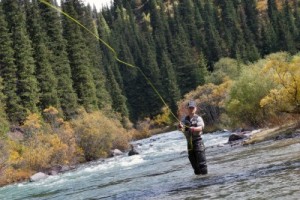 Moving into winter, most fly fishers focus in on one type of fishing – redfish. Casting to tailing reds is most fly fisher’s idea of a “great day”. However, speckled trout have a secondary spawn during the fall. Keep in mind; your chances of a trophy are more likely during the primary spawn that takes place in the spring. Fall often offers the best opportunity for fly fishers to catch gator trout. The reason is simple: wind, or lack thereof. More fish spew more eggs in the spring so the fatter fish are swimming in the bays.
Moving into winter, most fly fishers focus in on one type of fishing – redfish. Casting to tailing reds is most fly fisher’s idea of a “great day”. However, speckled trout have a secondary spawn during the fall. Keep in mind; your chances of a trophy are more likely during the primary spawn that takes place in the spring. Fall often offers the best opportunity for fly fishers to catch gator trout. The reason is simple: wind, or lack thereof. More fish spew more eggs in the spring so the fatter fish are swimming in the bays.
Not every fish spawns in the fall. But, enough do to offer a better-than-average shot at catching a trophy trout. In addition, most every fish is beginning to add girth in anticipation of winter. The water temperatures reach a comfortable level, inspiring fish to cruise the shallows, much as they do in the spring. But, unlike spring, fall days are near-calm, giving fly casters of all levels a legitimate shot at casting the necessary distance to sunning sows.
Sight casting is the preferred method of taking trophy fish in areas where the water clarity allows it. However, be prepared to exercise your eyes. Trout, with their moss-green back, are considerably tougher to spot on grass flats than redfish. Concentrate on the fringes of sandy potholes, oyster clumps or other structure that offers a contrast. Specks, particularly the large versions, are also quite a bit spookier than reds in skinny water. So, be prepared to rip off a relatively long cast in minimal time. Not the easiest of tasks, but a thrilling pursuit nonetheless.
The other option is to blind cast. Again, the nearly windless days of fall are appreciated in this arena. The lack of wind allows for longer cast without nearly as much effort. The end result is covering more water, more comfortably.
This time of year, there is really no need to go extra small for the sight casting end of things. The same flies can be used for both sight and blind casting. Deceivers, snake flies and other baitfish imitating patterns are among the best. Floating or intermediate lines will suffice to deliver these flies, although intermediate is probably a little more functional for blind-casting over somewhat deeper water.
Redfish fly fishing is definitely prevalent in the fall, but never rule out the other option of taking Robert Frost’s “road less traveled” and that road leads you to the speckled trout.
Source: “Fly Fishing for Speckled Trout in Fall.” Fly Fishing for Speckled Trout in Fall. Web. 27 Nov. 2012.
Follow Us: Facebook – Foursquare – Twitter – YouTube – LinkedIn
